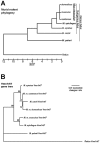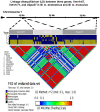A candidate subspecies discrimination system involving a vomeronasal receptor gene with different alleles fixed in M. m. domesticus and M. m. musculus
- PMID: 20844586
- PMCID: PMC2936562
- DOI: 10.1371/journal.pone.0012638
A candidate subspecies discrimination system involving a vomeronasal receptor gene with different alleles fixed in M. m. domesticus and M. m. musculus
Abstract
Assortative mating, a potentially efficient prezygotic reproductive barrier, may prevent loss of genetic potential by avoiding the production of unfit hybrids (i.e., because of hybrid infertility or hybrid breakdown) that occur at regions of secondary contact between incipient species. In the case of the mouse hybrid zone, where two subspecies of Mus musculus (M. m. domesticus and M. m. musculus) meet and exchange genes to a limited extent, assortative mating requires a means of subspecies recognition. We based the work reported here on the hypothesis that, if there is a pheromone sufficiently diverged between M. m. domesticus and M. m. musculus to mediate subspecies recognition, then that process must also require a specific receptor(s), also sufficiently diverged between the subspecies, to receive the signal and elicit an assortative mating response. We studied the mouse V1R genes, which encode a large family of receptors in the vomeronasal organ (VNO), by screening Perlegen SNP data and identified one, Vmn1r67, with 24 fixed SNP differences most of which (15/24) are nonsynonymous nucleotide substitutions between M. m. domesticus and M. m. musculus. We observed substantial linkage disequilibrium (LD) between Vmn1r67 and Abpa27, a mouse salivary androgen-binding protein gene that encodes a proteinaceous pheromone (ABP) capable of mediating assortative mating, perhaps in conjunction with its bound small lipophilic ligand. The LD we observed is likely a case of association rather than residual physical linkage from a very recent selective sweep, because an intervening gene, Vmn1r71, shows significant intra(sub)specific polymorphism but no inter(sub)specific divergence in its nucleotide sequence. We discuss alternative explanations of these observations, for example that Abpa27 and Vmn1r67 are coevolving as signal and receptor to reinforce subspecies hybridization barriers or that the unusually divergent Vmn1r67 allele was not a product of fast positive selection, but was derived from an introgressed allele, possibly from Mus spretus.
Conflict of interest statement
Figures




Similar articles
-
Do changes in gene expression contribute to sexual isolation and reinforcement in the house mouse?Mol Ecol. 2017 Oct;26(19):5189-5202. doi: 10.1111/mec.14212. Epub 2017 Jul 16. Mol Ecol. 2017. PMID: 28626946
-
The complex history of a gene proposed to participate in a sexual isolation mechanism in house mice.Mol Biol Evol. 2002 Apr;19(4):462-71. doi: 10.1093/oxfordjournals.molbev.a004102. Mol Biol Evol. 2002. PMID: 11919288
-
Dynamic evolution of V1R putative pheromone receptors between Mus musculus and Mus spretus.BMC Genomics. 2009 Feb 9;10:74. doi: 10.1186/1471-2164-10-74. BMC Genomics. 2009. PMID: 19203383 Free PMC article.
-
Evolution of V1R pheromone receptor genes in vertebrates: diversity and commonality.Genes Genet Syst. 2019 Oct 30;94(4):141-149. doi: 10.1266/ggs.19-00009. Epub 2019 Oct 2. Genes Genet Syst. 2019. PMID: 31474650 Review.
-
Vomeronasal Receptors in Vertebrates and the Evolution of Pheromone Detection.Annu Rev Anim Biosci. 2017 Feb 8;5:353-370. doi: 10.1146/annurev-animal-022516-022801. Epub 2016 Nov 28. Annu Rev Anim Biosci. 2017. PMID: 27912243 Review.
Cited by
-
The microevolution of V1r vomeronasal receptor genes in mice.Genome Biol Evol. 2011;3:401-12. doi: 10.1093/gbe/evr039. Epub 2011 Jun 1. Genome Biol Evol. 2011. PMID: 21551350 Free PMC article.
-
Genomic variation in the vomeronasal receptor gene repertoires of inbred mice.BMC Genomics. 2012 Aug 21;13:415. doi: 10.1186/1471-2164-13-415. BMC Genomics. 2012. PMID: 22908939 Free PMC article.
-
Evolution of the ABPA subunit of androgen-binding protein expressed in the submaxillary glands in New and Old World rodent taxa.J Mol Evol. 2013 May;76(5):324-31. doi: 10.1007/s00239-013-9561-4. Epub 2013 May 1. J Mol Evol. 2013. PMID: 23636475
-
Androgen-Binding Protein (Abp) Evolutionary History: Has Positive Selection Caused Fixation of Different Paralogs in Different Taxa of the Genus Mus?Genome Biol Evol. 2021 Oct 1;13(10):evab220. doi: 10.1093/gbe/evab220. Genome Biol Evol. 2021. PMID: 34581786 Free PMC article.
-
Male pheromones and their reception by females are co-adapted to affect mating success in two subspecies of brown rats.Curr Zool. 2020 Oct 23;67(4):371-382. doi: 10.1093/cz/zoaa066. eCollection 2021 Aug. Curr Zool. 2020. PMID: 34671704 Free PMC article.
References
-
- Karlson P, Luscher M. Pheromones': a new term for a class of biologically active substances. Nature. 1959;183:55–56. - PubMed
-
- Tirindelli R, Dibattista M, Pifferi S, Menini A. From pheromones to behavior. Physiol Rev. 2009;89:921–956. - PubMed
-
- Touhara K, Vosshall LB. Sensing odorants and pheromones with chemosensory receptors. Annu Rev Physiol. 2009;71:307–332. - PubMed
-
- Beauchamp GK, Yamazaki K. Chemical signaling in mice. Biochem Soc Trans. 2003;31:147–151. - PubMed
Publication types
MeSH terms
Substances
Grants and funding
LinkOut - more resources
Full Text Sources
Molecular Biology Databases
Research Materials

